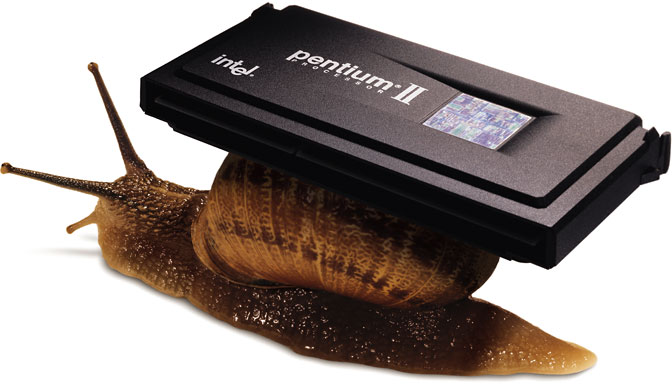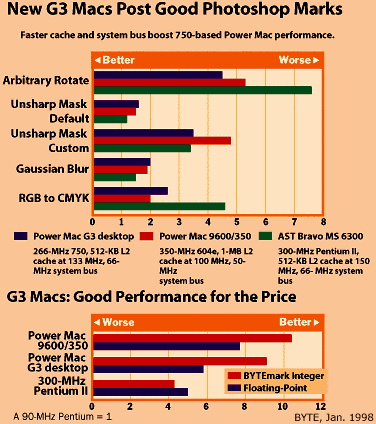1998 – If you’ve seen the snail, you love the snail. Apple’s incredible new ad pulls no punches, bragging to the world that a Power Mac G3 is up to twice as fast as a Pentium II PC.

Apple has the benchmarks to prove it, thanks to BYTE magazine’s cross-platform BYTEmark. As I noted on Low End Mac three months ago (the day I received the November 1997 issue of BYTE), the PowerPC 750 (a.k.a. G3) blows past the Pentium II, whether in integer or floating point math.
That’s what Apple points out in these brilliantly executed ads. “They’re not the fastest. We’re faster.”
 Since the November BYTE, Intel began shipping Deschutes, the next generation Pentium II using a 0.25-micron die (PPC 750 uses a 0.29-micron die). According to the March 1998 BYTE, Deschutes offers nothing new – only more speed.
Since the November BYTE, Intel began shipping Deschutes, the next generation Pentium II using a 0.25-micron die (PPC 750 uses a 0.29-micron die). According to the March 1998 BYTE, Deschutes offers nothing new – only more speed.
The Pentium II is designed for a 66 MHz system bus and comes with a fixed 512 KB Level 2 cache running at half CPU speed. That means the hotshot 333 MHz Pentium II is using a smaller, slower cache than top-end G3 daughter cards.
To make matters worse, it’s also a less efficient design, still rooted in the CISC technology of the late 1970s. And the beast is still an energy hog, pulling 23.7W at 333 MHz, several times as much as the efficient RISC design of the PPC 750.
The latest BYTEmark pegs the 333 MHz Pentium II at 4.7 for integer performance, 5.3 for floating point. In comparison, the discontinued PPC 604e at 350 MHz hits 10.3 on the integer test and 7.6 on floating point. When BYTE tested a prototype 275 MHz G3 system, it produced a 9.4 integer benchmark, 6.1 floating point.
Apple BYTEmarked the G3/233 and G3/266 against the Compaq 5100 PII/300 and 4860 PII/333, publishing these integer results on their site:
Pentium II, 300 MHz 4.26 Pentium II, 333 MHz 4.64 Power Mac G3, 233 MHz 7.88 - 69.8% faster than PII/333 Power Mac G3, 266 MHz 9.01 - 94.2% faster than PII/333
Of course, there are faster Power Macs, thanks to G3 daughter cards with 1 MB 1:1 backside caches – and 350-400 MHz PPC 750s are just around the corner.
Intel plans to fight back with 300-400 MHz versions of the Pentium II. These will finally support a 1:1 backside cache with 1-2 MB BSRAM and a 100 MHz system bus. This will be a significant improvement over the 2:1 512 KB cache and 66 MHz bus currently offered, but only motherboards with the brand new Slot 2 architecture can take the upgrade.
Contrast this with Apple’s G3 motherboard, which is already designed to support 75 MHz and 83 MHz bus speeds. Assuming Apple used fast enough components, it may be possible to drop in a new PPC 750 with 1 MB backside cache and run past 500 MHz. (More details in Clocking the G3.)
At the same time, expect the folks making G3 daughter cards to offer 400 MHz CPUs with 1 MB 1:1 caches as soon as possible, allowing owners of pre-G3 PCI Power Macs (those with CPUs on daughter cards) to upgrade.
Despite the hype, Pentium II is not a snail. It still has a few years ahead of it. It’s a great CPU for those who buy the Windows hype.
But compared with the PPC 750, Intel’s finest does look sluggish.
Kudos to Apple and the minds behind the snail ad!
Keywords: #bytemark #benchmarks #g3vspentium
Short link: http://goo.gl/G2TdTf

